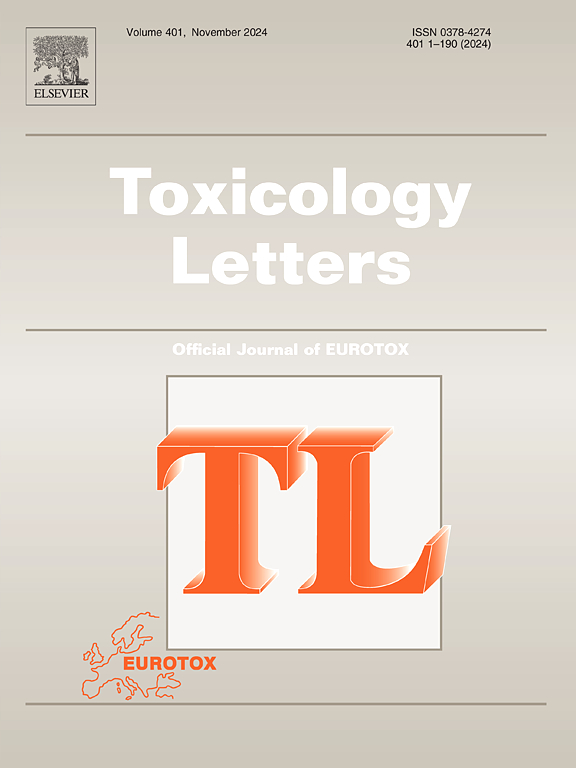香熏的神经毒性和发育效应:网络毒理学和斑马鱼模型研究。
IF 2.9
3区 医学
Q2 TOXICOLOGY
引用次数: 0
摘要
焚香是许多文化中的传统习俗,尤其是在东南亚。虽然焚香通常被认为是神圣而有益的,但现代焚香却含有各种可能对健康造成危害的化学物质。对 ICS 进行的 GCMS 分析发现了潜在的化合物。网络毒理学发现,ICS 中含有的化合物违反了利宾斯基的 "五种规则",从而导致潜在的神经毒性效应。受影响的主要途径包括神经活性配体-受体相互作用和钙信号转导,这与帕金森氏症和阿尔茨海默氏症等神经退行性疾病有关。其中涉及的重要基因包括 STAT3、BCL2 和 MTOR,强调了 ICS 暴露的化学危害性。我们以斑马鱼(Danio rerio)胚胎为模式研究了 ICS 的毒性。接触 ICS 会导致毒性随剂量而增加。高浓度(7 微克/毫升和 14 微克/毫升)会导致立即死亡,而低浓度(0.1、0.3、0.5 和 1 微克/毫升)则会导致发育缺陷,如卵黄囊水肿、骨骼畸形和心包水肿。死亡率随浓度升高而升高,这证实了暴露于 ICS 会导致运动机能减退,行走距离和速度毒性降低。较高浓度的 ICS 会导致 ROS 水平升高和细胞损伤,染色水平升高就是证明。观察到脂质过氧化(DPPP 试验)和脂质积累(尼罗河红试验)呈剂量依赖性增加。ICS 浓度越高,脂质氧化损伤越严重,脂质沉积越多。酶测定显示,接触 ICS 后,抗氧化酶 SOD 和 CAT 的活性明显降低,表明抗氧化防御能力受损,同时 LDH 活性升高,表明组织损伤和细胞毒性。基因表达分析表明,SOD1 和 CAT 基因下调,炎症基因 TNF-α 和 IL-1β 上调,凋亡基因 p53 表达增加,Bcl-2 和 BDNF 表达减少。这些发现突出表明,ICS 有可能导致氧化应激、炎症、细胞凋亡和神经发育障碍。本文章由计算机程序翻译,如有差异,请以英文原文为准。
Neurotoxic and developmental effects of scented incense stick smoke: Network toxicology and zebrafish model study
Burning incense sticks is a traditional practice in many cultures, especially in Southeast Asia. While it is often regarded as sacred and beneficial, modern incense sticks contain various chemicals that can pose health risks. A GCMS analysis of the ICS revealed potential compounds. Network toxicology revealed that ICS contains compounds violating Lipinski's rule of five, leading to potential neurotoxic effects. Key pathways affected include neuroactive ligand-receptor interaction and calcium signaling, associated with neurodegenerative diseases like Parkinson's and Alzheimer's. Significant genes involved are STAT3, BCL2, and MTOR, emphasizing the chemical hazards of ICS exposure. We investigated the toxicity of ICS using zebrafish (Danio rerio) embryos as a mode. ICS exposure resulted in a dose-dependent increase in toxicity. High concentrations (7 and 14 µg/ml) led to immediate mortality, while lower concentrations (0.1, 0.3, 0.5, and 1 µg/ml) caused developmental defects such as yolk sac edema, skeletal malformations, and pericardial edema. Mortality rates increased with higher concentrations, confirming dose-dependent ICS exposure caused hypoactive locomotion, with reduced distance traveled and velocity toxicity. Higher concentrations of ICS led to increased ROS levels and cellular damage, as evidenced by enhanced staining levels. A dose-dependent increase in lipid peroxidation (DPPP assay) and lipid accumulation (Nile red assay) was observed. Higher ICS concentrations led to significant oxidative damage to lipids and increased lipid deposition. Enzymatic assays showed that ICS exposure significantly decreased the activities of antioxidant enzymes SOD and CAT, indicating impaired antioxidant defense, while increasing LDH activity, signaling tissue damage and cytotoxicity. Gene expression analysis revealed downregulation of SOD1 and CAT genes, upregulation of inflammatory genes TNF-α and IL-1β, and increased expression of the apoptotic gene p53 with decreased expression of Bcl-2 and BDNF. These findings highlight ICS's potential to cause oxidative stress, inflammation, apoptosis, and neurodevelopmental impairments.
求助全文
通过发布文献求助,成功后即可免费获取论文全文。
去求助
来源期刊

Toxicology letters
医学-毒理学
CiteScore
7.10
自引率
2.90%
发文量
897
审稿时长
33 days
期刊介绍:
An international journal for the rapid publication of novel reports on a range of aspects of toxicology, especially mechanisms of toxicity.
 求助内容:
求助内容: 应助结果提醒方式:
应助结果提醒方式:


